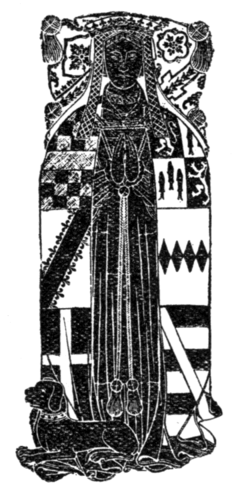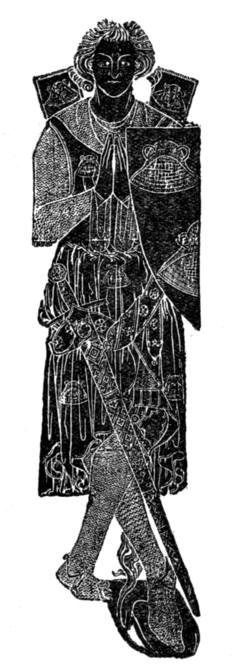CHAPTER IV
HERALDIC BRASSES
By Rev. WALTER J. KAYE, Junr., B.A., F.S.A., F.S.A. Scot.
Member of the Monumental Brass Society, London; Honorary Member of the Spalding Gentlemen's Society; Author of "A Brief History of Gosberton, in the County of Lincoln."
MONUMENTAL brasses do not merely afford a guide to the capricious changes of fashion in armour, in ecclesiastical vestments (which have altered but little), and in legal, civilian, and feminine costume, but they provide us also with a vast number of admirable specimens of heraldic art. The vandal and the fanatic have robbed us of many of these beautiful memorials, but of those which survive to our own day the earliest on the continent of Europe marks the last resting-place of Abbot Ysowilpe, 1231, at Verden, in Hanover. In England there was once a brass, which unfortunately disappeared long ago, to an Earl of Bedford, in St. Paul's Church, Bedford, of the year 1208, leaving 1277 as the date of the earliest one.
Latten (Fr. laiton), the material of which brasses were made, was at an early date manufactured in large quantities at Cologne, whence plates of this metal came to be known as cullen (Köln) plates; these were largely exported to other countries, and the Flemish workmen soon attained the greatest proficiency in their engraving. Flemish brasses are usually large and rectangular, having the space between the figure and the marginal inscription filled either by diaper work or by small figures in niches. Brasses vary considerably in size: the matrix of Bishop Beaumont's brass in Durham Cathedral measures about 16 feet by 8 feet, and the memorial to Griel van Ruwescuere, in the chapel of the Lady Superior of the Béguinage at Bruges, is only about 1 foot square. Brazen effigies are more numerous in England in the eastern and southern counties, than in parts more remote from the continent of Europe.
Armorial bearings are displayed in a great variety of ways on monumental brasses, some of which are exhibited in the rubbings selected for illustration. In most cases separate shields are placed above and below the figures. They occur also in the spandrils of canopies and in the shafts and finials of the same, as well as in the centre and at the angles of border-fillets. They naturally predominate in the memorials of warriors, where we find them emblazoned not only on shield and pennon but on the scabbard and ailettes, and on the jupon, tabard, and cuirass also, while crests frequently occur on the tilting-helm. In one case (the brass of Sir Peter Legh, 1527, at Winwick, co. Lancaster) they figure upon the priestly chasuble. Walter Pescod, the merchant of Boston, Lincolnshire, 1398, wears a gown adorned with peascods—a play upon his name; and many a merchant's brass bears his coat of arms and merchant's mark beside, pointing a moral to not a few at the present day. The fifteenth and sixteenth centuries witnessed the greatest profusion in heraldic decoration in brasses, when the tabard and the heraldic mantle were evolved. A good example of the former remains in the parish church of Ormskirk, Lancashire, in the brass commemorating a member of the Scarisbrick family, c. 1500 (Fig. 21). Ladies were accustomed at this time to wear their husband's arms upon the mantle or outer garment and their own upon the kirtle, but the fashion which obtained at a subsequent period was to emblazon the husband's arms on the dexter and their own on the sinister side of the mantle (Fig. 22).
The majority of such monuments, as we behold them now, are destitute of any indications of metals or tinctures, largely owing to the action of the varying degrees of temperature in causing contraction and expansion. Here and there, however, we may still detect traces of their pristine glory. But these matters received due attention from the engraver. To represent or, he left the surface of the brass untouched, except for gilding or perhaps polishing; this universal method has solved many heraldic problems. Lead or some other white metal was inlaid to indicate argent, and the various tinctures were supplied by the excision of a portion of the plate, thereby forming a depression, which was filled up by pouring in some resinous substance of the requisite colour. The various kinds of fur used in armory may be readily distinguished, with the sole exception of vair (argent and azure), which presents the appearance of a row of small upright shields alternating with a similar row reversed.
The earliest brass extant in England is that to Sir John D'Aubernoun, the elder (Fig. 23), at Stoke D'Abernon, in Surrey, which carries us back to the year 1277. The simple marginal inscription in Norman-French, surrounding the figure, and each Lombardic capital of which is set in its own matrix, reads: "Sire: John: Daubernoun: Chivaler: Gist: Icy: Deu: De: Sa: Alme: Eyt: Mercy:"[1] In the space between the inscription and the upper portion of the figure were two small shields, of which the dexter one alone remains, charged with the
arms of the knight: "Azure, a chevron, or." Sir John D'Aubernoun is represented in a complete panoply of chain mail—his head being protected by a coif de mailles, which is joined to the hauberk or mail shirt, which extends to the hands, having apparently no divisions for the
fingers, and being tightened by straps at the wrists. The legs, which are not crossed, are covered by long chausses, or stockings of mail, protected at the knees by poleyns or genouillères of cuir bouilli richly ornamented
by elaborate designs. A surcoat, probably of linen, depends from the shoulders to a little below the knees, and is cut away to a point above the knee. This garment is tightly confined (as the creases in the surcoat show) at the waist by a girdle, and over it is passed a guige whereto the long sword is attached. "Pryck" spurs are fixed to the instep, and the feet rest upon a lion, whose mouth grasps the lower portion of a lance. The lance bears a pennon charged with a chevron, as also is the small heater-shaped shield borne on the knight's left arm. The whole composition measures about eight feet by three.
Heraldry figures more prominently in our second illustration, the brass to Sir Roger de Trumpington, 1289 (Fig. 24). This fine effigy lies under the canopy of an altar-tomb, so called, in the Church of St. Michael and All Angels, Trumpington, Cambridgeshire. It portrays the knight in armour closely resembling that already described, with these exceptions: the head rests upon a huge heaume, or tilting-helm, attached by a chain to the girdle, and the neck is here protected from side-thrusts by ailettes or oblong plates fastened behind the shoulders, and bearing the arms of Sir Roger. A dog here replaces the lion at the feet, the lance and pennon are absent, and the shield is rounded to the body. On this brass the arms not only occur upon the shield, but also upon the ailettes, and are four times repeated on the scabbard. They afford a good example of "canting" arms: "Azure, crusilly and two trumpets palewise or, with a label of five points in chief, for difference." It is interesting also to notice that the engraver had not completed his task, for the short horizontal lines across the dexter side of the shield indicate his intention of cutting away the surface of the field.
Sir Robert de Setvans (formerly Septvans), whose beautiful brass may be seen at Chartham, Kent, is habited in a surcoat whereon, together with the shield and ailettes, are seven winnowing fans—another instance of canting arms (Fig. 25). This one belongs to a somewhat later date, 1307.
Our next example is a mural effigy to Sir William de Aldeburgh, c. 1360, from the north aisle of Aldborough Church, near Boroughbridge, Yorkshire (Fig. 26). He is attired like the "veray parfite gentil knight" of Chaucer, in a bascinet or steel cap, to which is laced the camail or tippet of chain mail, and a hauberk almost concealed by a jupon, whereon are emblazoned his arms: "Azure, a fess indented argent, between three crosslets botony, or." The first crosslet is charged with an annulet, probably as a mark of cadency. The engraver has omitted the indenture upon the fess, which, however, appears upon the shield. The knight's arms are protected by epaulières, brassarts, coutes, and vambraces; his hands, holding a heart, by gauntlets of steel. An elaborate baldric passes round his waist, from which are suspended, on the left, a cross-hilted sword, in a slightly ornamented scabbard; on the right, a misericorde, or dagger of mercy. The thighs are covered by cuisses—steel plates, here deftly concealed probably by satin or velvet secured by metal studs—the knees by genouillères, the lower leg by jambes, which reveal chausses of mail at the interstices. Sollerets, or long, pointed shoes, whereto are attached rowel spurs, complete his outfit. The figure stands upon a bracket bearing the name "Will's de Aldeburgh."
The parish church of Eastington, Gloucestershire, contains a brass to Elizabeth Knevet, which is illustrated and described by Mr. Cecil T. Davis at p. 117 of his excellent work on the "Monumental Brasses of Gloucestershire."[2] The block (Fig. 27), which presents a good example of the heraldic mantle, has been very kindly placed at my disposal by Mr. Davis. To confine our description to the heraldic portion of the brass, we find the following arms upon the mantle:—
"Quarterly, 1. argent, a bend sable, within a bordure engrailed azure (Knevet); 2. argent, a bend azure, and chief, gules (Cromwell); 3. chequy or and gules, a chief ermine (Tatshall); 4. chequy or and gules, a bend ermine (De Cailly or Clifton); 5. paly of six within a bordure bezanté.... 6. bendy of six, a canton...."[3]
A coat of arms occurs also at each corner of the slab: "Nos. 1 and 4 are on ordinary shields, and 2 and 3 on lozenges. Nos. 1 and 3 are charged with the same bearings as are on her mantle. No. 2, on a lozenge, quarterly, 1. Knevet; 2. Cromwell; 3. Tatshall; 4. Cailli; 5. De Woodstock; 6. paly of six within a bordure; 7. bendy of six, a canton; 8. or, a chevron gules (Stafford); 9. azure, a bend cottised between six lioncels rampant, or (de Bohun). No. 4 similar to No. 1, with the omission of 2 and 3."
In later times thinner plates of metal were employed, a fact which largely contributed to preclude much of the boldness in execution hitherto displayed. A prodigality in shading, either by means of parallel lines or by cross-hatching, also tended to mar the beauty of later work of this kind. Nevertheless there are some good brasses of the Stuart period. These sometimes consist of a single quadrangular plate, with the upper portion occupied by armorial bearings and emblematical figures, the centre by an inscription, and the lower portion by a representation of the deceased, as at Forcett, in the North Riding of Yorkshire. Frequently, however, as at Rotherham and Rawmarsh, in the West Riding of the same county, the inscription is surmounted by a view of the whole family, the father kneeling on a cushion at a fald-stool, with his sons in a similar attitude behind him, and the mother likewise engaged with her daughters on the opposite side, while the armorial insignia find a place on separate shields above.






